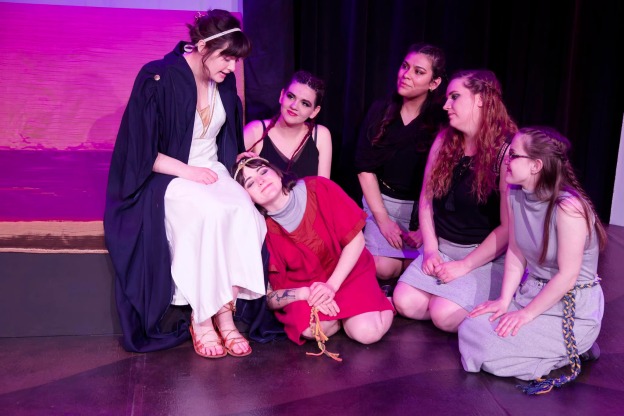Set for Subscribe or Like, design Stephanie Bahniuk.
The last event in Workshop West’s season is the world premiere production of Liam Salmon’s Subscribe or Like, directed by Kate Ryan.
On entering the Gateway Theatre’s auditorium, the audience sees a simple box set presenting a room in a small basement apartment. But it’s set on an angle, and there is no drapery backing it or surrounding it. One can’t forget that this room is on a stage – and when the lights dimmed and the play was about to start, we could see each actor entering the backstage space from the lobby, before entering the apartment’s front door as the characters. This cannot be an accident (Stephanie Bahniuk, set and costume design).
The characters living in this apartment were a young couple, Rachel (Gabby Bernard) and Miles (Geoffrey Simon Brown). He’s unemployed, trying to find work commensurate with his marketing degree instead of joining her at the coffee shop where she’s a part-time barista, and he has a toothache. Their socioeconomic situation is tacitly illustrated by the fact that the dialogue never considers taking the toothache to a dentist – he treats it with a salt-water rinse and she doesn’t comment. Miles likes to make and share “prank” videos, often involving scaring or surprising his girlfriend. She doesn’t seem to enjoy this. It’s clear that both are unhappy with their lives – it’s less clear whether they are still happy with each other.
Miles continues posting his videos on a YouTube channel, and talks about reaching enough subscribers to make money with it. Rachel co-operates – they talk about whether the stunts work better when scripted or when she is truly surprised – and then she starts adding some of her own content to the channel. They start adding viewers, likes, subscribers. They seem – if not happier, then at least more engaged – and they focus more on how to attract and keep the viewers, making some more extreme choices (including one or two that I could hardly bear to watch).
Another feature of the show’s design was the extensive use of video (Ian Jackson, multimedia design) to show or evoke online content. I think there were nine large LCD screens suspended outside the room, and sometimes the content was also projected across the walls and floor of the apartment. So “the set” is clearly not just the room in their apartment, but also … the internet? The video isn’t just clips from their YouTube channel, but some of the comments.
And this is important, because the comments affect the characters. In one disturbing but credible exchange, Miles explains to Rachel that the trope of misogynistic commenting generating more interest in the channel is a common phenomenon and a good thing for the channel.
When they talk about whether stopping the posts might be a good next step for them as people and as a couple, Miles protests that the channel matters to the viewers. “But they’re not real!“, protests Rachel.
It is very odd to be writing a blog post about this play, wondering if people will read it, and wondering if reading this post will influence them to go see the play. (See it! It’s good! It’s entertaining, it’s horrifying, and it made us stand in the parking lot for ages talking about the issues raised.) While YouTube is not my medium, I know that online communities are real. This … I was going to say corner of the blogosphere, but spheres shouldn’t have corners? … isn’t particularly interactive, but I know it’s still contributing to community. And just as I notice how many people viewed my blog post or Instagram story, liked my Facebook post, or clicked Agree on my Ravelry forum comment, I know that a playwright is a content creator too. Other artistic contributors like actors and designers are also engaged in presenting the work to the audiences in the auditorium. Part of why I blog is that I want the theatre artists to know they have moved me and made me think. And the Subscribe or Like playwright and team did.
Subscribe or Like is playing at the Gateway Theatre (formerly Roxy on Gateway, formerly C103) until June 11th. Tickets are available here.




